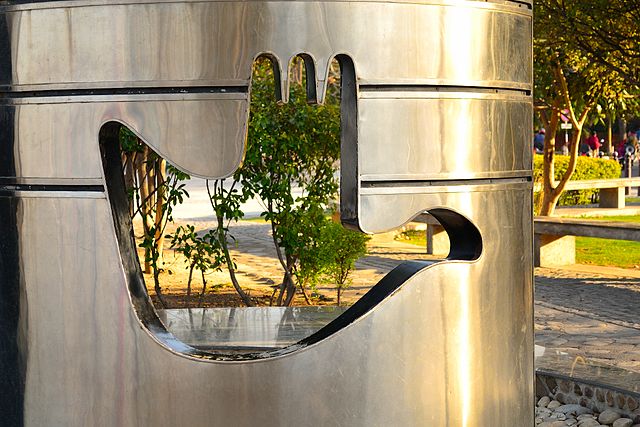 |
| Open Hand Monument - Chandigarh/Image Source: Shashank |
Along with the cities of Panchkula (Haryana), Kharar, Kurali, Mohali, and Zirakpur (Punjab), Chandigarh forms the Greater Chandigarh (also known as Chandigarh Capital Region).
Chandigarh is the first planned city in post-independent India. The master plan of the city was prepared by Swiss-French architect Le Corbusier, who transpired the work of Polish architect Maciej Nowicki and the American planner Albert Mayer.
In 2016, Chandigarh's Capitol Complex was declared World Heritage site by UNESCO.
The combined population of Chandigarh, Mohali, and Panchkula (known as Tri-City) is more than 2 million.
| Chandigarh Facts | |
|---|---|
| Established | 1 November 1966 |
| Total Area | 114 Km² |
| Longitude | 76°47' 14 E |
| Latitude | 30° 44'14 N |
| Area Rank | 34th |
| Altitude | 304-365 meters above sea level |
| Annual Rainfall | 82.67mm/year |
| Temperature | 5°C-14°C (Winters); 28°C-42°C (Summer) |
| Monsoon | July-September |
| Population | 1055450 (2011) |
| Population Density | 9,258 per sq. km. (2011) |
| Sex Ratio | 818 (2011) |
| Decadal Population Growth | 17.2%(2001-2011) |
| Birth Rate | 11.74 |
| Death Rate | 4.18 |
| Infant Mortality | 20.96 |
| Literacy | 86.05% |
| Languages | English, Punjabi, Hindi |
| Number of Villages | 22 |
| Pincode | 160XXX |
| State Emblem | Open Hand |
| State Animal | Indian Grey Mongoose |
| State Bird | Indian Grey Hornbill |
| State Tree | Blue Jacaranda |
| State Flower | Dhak (Palash) |
History
The name Chandigarh is formed by two Sanskrit words "Chandi" and "Garh" Chandi refers to Hindu Goddess Chandi, an avatar of Goddess Parvati, and Garh means the fort. There is a Chandi Devi temple near the city of Panchkula.
The sobriquet of "The City Beautiful" came from the popular North American urban planning philosophy during the early 1900s. In an interview, Albert Mayer, earlier planner of the City, said, "We want to create a beautiful city..."
The Chandigarh region is known to Harappan people, and researchers have found evidence of earlier settlements.
Chandigarh is planned after the partition of India in 1947. The state of Punjab was divided into two regions East Punjab (India) and West Punjab (Pakistan). Lahore, the Capital of United Punjab, went with West Punjab. Thus, creating a vacant space for the Capital region for East Punjab.
Till, the completion of Chandigarh in 1960, Shimla served as temporary capital of East Punjab.
On 1 November 1966, a new state of Haryana was carved out of Punjab for Haryanvi speaking people; Western region of Eastern Punjab was renamed as Punjab, and Chandigarh was recognised as Union Territory, which will serve as Capital City to both states.
Geography
Chandigarh is sitated on the foothills of Shivalik range of Himalayas.
Chandigarh has a humid subtropical climate region with hot summer, mild winters, and unreliable rain.
Banyan, Eucaplyptus, Ashoka, Cassia, Mullberry and other trees form the ecosystem of the city.
The fauna inlcudes Deer, Sambar, Barking Deer, Parrot, Woodpecker, and peaccocks.
Sukhna lake, a 3 km² man-made rain fed lake was created in 1958 by damming Sukhna choe. The Sukhna lake hosts many gardens and parks, which includes Garden of Silence, Nek Chand Garden of Rocks and Zakir Hussain Rose Garden.
Demography
Chandigarh has population of 1055450 and density of 9252 person per square kilometer. Male constitues 55% and female 45% of total population, making the UT, third lowest in terms of sex ratio at 818 females per 1000 males.
Languages
English is the sole official language of Chandigarh. However, the majority of the population speaks Hindi and Punjabi. There are more than 65% of people who speak Hindi and 27% of people who speak Punjabi. There is a small population who speak Urdu and Tamil. Additionally, there are few tribal people who speak Bauria (also known as Wagdi and Vaghiri) in Chandigarh.
Economy
According to RBI 2012 data, Chandigarh is the third largest deposit and seventh largest credit centre of the country.
Government is major employer in the city of Chandigarh. Other major economy driving industries are Paper, Basic metals, Alloys, Machinery, Food Products, and Electronics.
Other Facts
In 2007, Chandigarh was declared as the first smoke-free city of India.
In month of february, Chandigarh celebrates Rose Festival. Similarly, during June, the city celebrates its famous Mango Festival.
Central Scientific Instruments Organisation (CSIO), national laboratory dedicated to research, design, and develop scientific and industrial instruments, is situated in Chandigarh.
As the number "13" is considered as unlucky. There is no sector 13 in Chandigarh and Panchkula.
Further reading:
Administrator of Chandigarh
